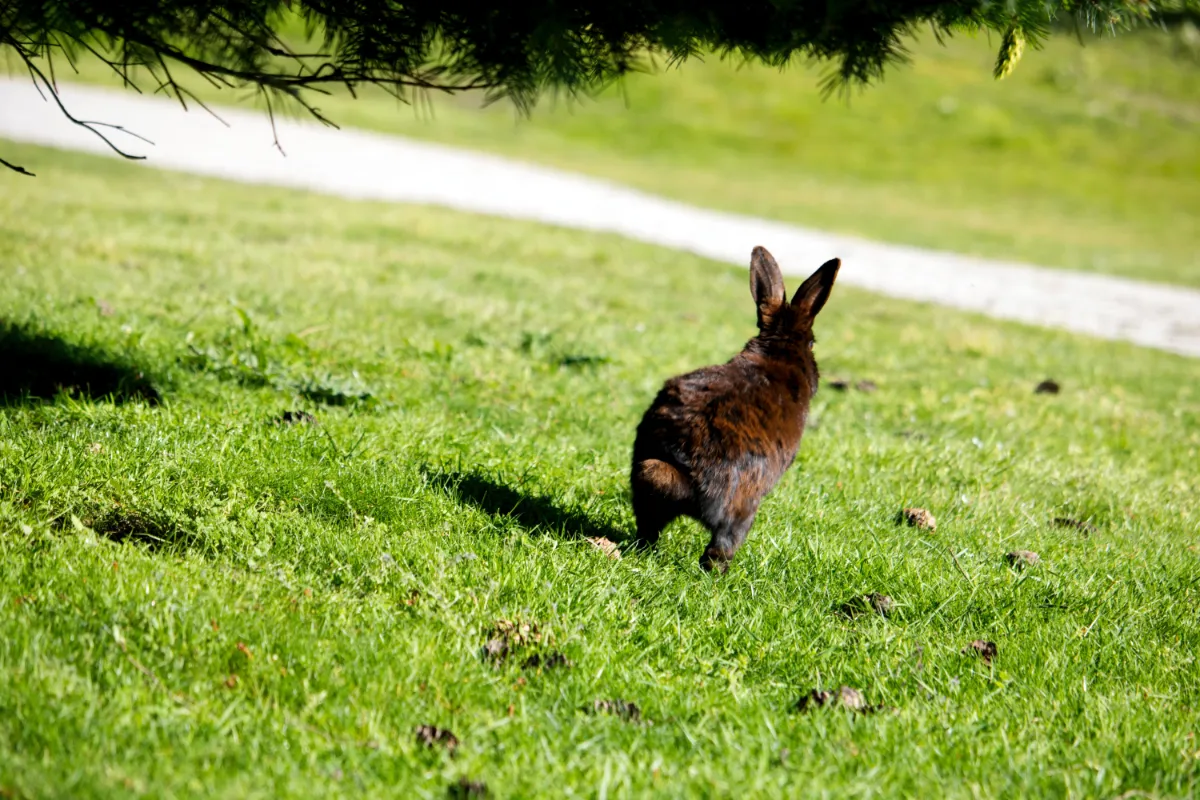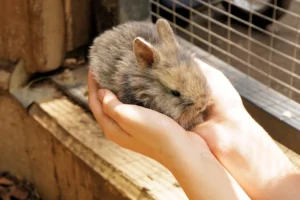The rabbits are natural-born leapers, capable of impressive feats of agility.
In this article, we’ll delve into the fascinating world of rabbit jumps, exploring their anatomy, jumping abilities, and training techniques.
Discover the different types of jumps rabbits can perform, as well as the factors that affect their jumping prowess.
Whether you’re a proud rabbit owner or simply curious about these furry acrobats, get ready to be amazed by their jumping skills!
In This Article
- 1 Key Takeaways
- 2 The Anatomy of a Rabbit’s Jump
- 3 How High Can Rabbits Jump
- 4 The Different Types of Rabbit Jumps
- 5 Factors That Affect a Rabbit’s Jumping Ability
- 6 Training Techniques to Improve Your Rabbit’s Jump
- 7 Fun Facts About Rabbits’ Jumping Skills
- 8 Common Misconceptions About Rabbit Jumps
- 9 Tips for Creating an Enriching Jumping Environment for Your Rabbit
- 10 Frequently Asked Questions
- 10.1 How Do Rabbits Use Their Ears While Jumping?
- 10.2 Can Rabbits Jump Higher Than Cats or Dogs?
- 10.3 Are There Any Health Risks Associated With Rabbits Jumping Too Much?
- 10.4 Do Rabbits Have a Specific Technique for Landing After a Jump?
- 10.5 Are There Any Specific Breeds of Rabbits That Are Better at Jumping Than Others?
Key Takeaways
- Rabbit jumps consist of three phases: crouch, push-off, and flight.
- Rabbits can jump surprisingly high, with some reaching heights of 39.2 inches.
- Competitive rabbit jumping events have gained popularity among rabbit enthusiasts.
- Factors like breed, age, and training can significantly influence a rabbit’s jumping ability.
The Anatomy of a Rabbit’s Jump
You can observe that a rabbit’s jump typically consists of three distinct phases.
Understanding the physics behind rabbit jumps and the muscles used can help you better serve these adorable creatures.
The first phase is the crouch, where the rabbit bends its hind legs and prepares to propel itself forward. This requires the contraction of the quadriceps muscles in the hind legs, providing the necessary force.
The second phase is the push-off, where the rabbit extends its hind legs forcefully. This action is powered by the gastrocnemius and soleus muscles in the calf.
Finally, the third phase is the flight, where the rabbit remains suspended in the air before landing. During this phase, the rabbit’s quadriceps muscles work to absorb the impact upon landing.
How High Can Rabbits Jump
Rabbits can jump surprisingly high, so it’s important to provide them with enough space to exercise and explore. When it comes to rabbit jumping competitions, these furry creatures can showcase their impressive vertical abilities.
Some famous rabbits, like Bini and Bandit, have gained recognition for their exceptional jumping skills. Bini, for instance, holds the Guinness World Record for the highest jump by a rabbit, reaching an astonishing height of 39.2 inches. This highlights the natural talent and agility that rabbits possess.
To ensure their well-being and happiness, it’s crucial to create an environment that encourages exercise and exploration. This includes providing ample space for rabbits to hop and leap to their heart’s content. By doing so, we can help these cute and agile animals fulfill their natural instincts while keeping them healthy and content.
The Different Types of Rabbit Jumps
Although there are various types of jumps that rabbits can perform, it’s fascinating to see how their unique abilities and techniques vary from one jump to another.
Rabbits have a natural inclination for jumping, and some breeds are particularly renowned for their jumping abilities. Competitive rabbit jumping events have gained popularity among rabbit enthusiasts, allowing rabbits to showcase their impressive skills. These events not only serve as a platform for owners to exhibit their rabbits’ jumping prowess but also create a sense of community among rabbit lovers.
Some rabbit breeds, such as the Belgian Hare and the English Spot, are known for their agility and high jumping capabilities. Observing rabbits in action during these events provides a captivating insight into the diverse range of jumps they can execute with precision and grace.
Factors That Affect a Rabbit’s Jumping Ability
Sure, it’s interesting how factors like breed, age, and training can significantly influence a rabbit’s jumping ability. Rabbit jump training is a great way to enhance their natural jumping skills and provide mental stimulation. By participating in rabbit jumping competitions, not only do rabbits get to showcase their abilities, but they also reap several benefits. Firstly, these competitions promote physical fitness and overall well-being for the rabbits. It helps them maintain a healthy weight and enhances their cardiovascular health. Secondly, rabbit jumping competitions provide a platform for social interaction, allowing rabbits to bond with their owners and other rabbits. Finally, these competitions stimulate the rabbit’s mind, improving their problem-solving skills and boosting their confidence. So, if you have a rabbit, consider getting involved in rabbit jump training and competitions to see the positive impact it can have on your furry friend.
| Factors That Affect a Rabbit’s Jumping Ability | Breed | Age | Training |
|---|---|---|---|
| High Jumping Ability | Yes | Yes | Yes |
| Moderate Jumping Ability | Yes | Yes | Yes |
| Low Jumping Ability | Yes | Yes | Yes |
| No Jumping Ability | Yes | Yes | Yes |
Training Techniques to Improve Your Rabbit’s Jump
You can enhance your rabbit’s jumping ability by using different training techniques, such as through positive reinforcement and setting up obstacle courses.
Training techniques play a vital role in improving your rabbit’s jump height. Positive reinforcement involves rewarding your rabbit with treats or praise when they successfully complete a jump. This encourages them to continue practicing and increases their motivation.
Setting up obstacle courses with varying heights and distances challenges your rabbit to jump higher and farther. Gradually increasing the difficulty level will help them build strength and improve their jump height over time.
It’s important to remember that each rabbit is unique and may respond differently to training techniques. Patience, consistency, and understanding your rabbit’s capabilities will contribute to their overall success in jumping.
Fun Facts About Rabbits’ Jumping Skills
Did you know that rabbits can jump up to three feet high and over nine feet in length? It’s true! Rabbits have impressive jumping skills that often go unnoticed. These furry creatures aren’t only adorable, but they also possess incredible agility and athleticism.
In fact, there are even rabbit agility competitions where these talented bunnies showcase their jumping abilities. These events have gained popularity in recent years, attracting both participants and spectators alike. Some famous jumping rabbits have even become social media sensations, captivating audiences with their remarkable leaps and bounds.
Whether it’s for sport or entertainment, rabbit agility competitions and the incredible jumping skills of these furry athletes continue to capture the attention and admiration of people around the world. So next time you see a rabbit hopping around, take a moment to appreciate their remarkable jumping abilities.
Common Misconceptions About Rabbit Jumps
Don’t be fooled by the common misconceptions – rabbit jumps aren’t solely dependent on their hind legs but also require coordination and strength from their forelimbs. While it’s true that rabbits are known for their impressive hopping abilities, there’s more to their jumps than meets the eye. Here are some key points to consider:
- Contrary to popular belief, rabbits rely on both their hind legs and forelimbs to execute a successful jump.
- Their hind legs provide the initial power and propulsion, while their forelimbs help with balance and control.
- The coordination between their hind legs and forelimbs allows rabbits to make precise and agile movements.
Understanding the true nature of rabbit jumps has several benefits:
- It helps dispel the misconception that rabbits are solely reliant on their hind legs.
- It highlights the importance of overall strength and coordination in rabbits’ physical abilities.
- It allows us to appreciate the remarkable agility and adaptability of these small creatures.
Tips for Creating an Enriching Jumping Environment for Your Rabbit
To create an enriching jumping environment for your rabbit, incorporate various platforms and obstacles to encourage their natural jumping instincts.
Creating obstacles not only provides physical exercise for your furry friend but also mental stimulation. Start by setting up a series of platforms at different heights, allowing your rabbit to jump from one to another.
You can also create tunnels or hurdles for them to navigate through. By incorporating these obstacles, you’re creating a mini Bunny Olympics for your rabbit to participate in.
This won’t only keep them physically active but also mentally engaged, promoting their overall well-being. Remember to always prioritize your rabbit’s safety by ensuring that the platforms and obstacles are secure and stable.
Happy jumping!
Frequently Asked Questions
How Do Rabbits Use Their Ears While Jumping?
When rabbits jump, their ears play a crucial role. The position of their ears helps them maintain balance and navigate obstacles. The movements of their ears allow them to accurately judge distances and land safely.
Can Rabbits Jump Higher Than Cats or Dogs?
Yes, rabbits can jump higher than cats or dogs. Their comparative athleticism allows them to achieve impressive heights. The physics of their jumps involve powerful hind legs and a flexible spine, enabling them to leap gracefully.
Are There Any Health Risks Associated With Rabbits Jumping Too Much?
Jumping can have health benefits for rabbits, but it’s important to consider the risks. While rabbits are natural jumpers, they can injure themselves if they jump too much or land improperly.
Do Rabbits Have a Specific Technique for Landing After a Jump?
When rabbits jump, they have a specific landing technique to minimize impact on their joints. This helps prevent injuries and ensures their agility. Understanding and supporting this technique is crucial for their overall well-being.
Are There Any Specific Breeds of Rabbits That Are Better at Jumping Than Others?
There are certain breeds of rabbits that are naturally better at jumping due to their physical attributes. However, with proper training, any breed of rabbit can learn to jump and excel in agility.





